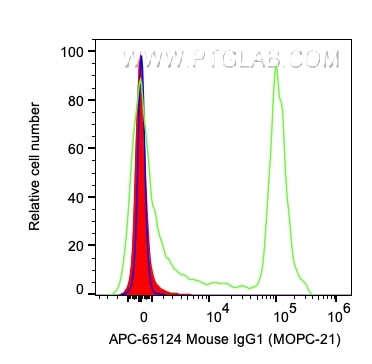IgG1 Isotype Control Monoklonaler Antikörper
IgG1 Isotype Control Monoklonal Antikörper für FC
Wirt / Isotyp
Maus / IgG1, kappa
Getestete Reaktivität
n/a
Anwendung
FC
Konjugation
APC Fluorescent Dye
CloneNo.
MOPC-21
Kat-Nr. : APC-65124
Synonyme
Geprüfte Anwendungen
| Erfolgreiche Detektion in FC |
Empfohlene Verdünnung
| Anwendung | Verdünnung |
|---|---|
| This reagent has been tested for flow cytometric analysis. It is recommended that this reagent should be titrated in each testing system to obtain optimal results. | |
| Sample-dependent, check data in validation data gallery | |
Veröffentlichte Anwendungen
| FC | See 2 publications below |
Produktinformation
APC-65124 bindet in FC IgG1 Isotype Control und zeigt Reaktivität mit n/a
| Getestete Reaktivität | n/a |
| Wirt / Isotyp | Maus / IgG1, kappa |
| Klonalität | Monoklonal |
| Typ | Antikörper |
| Immunogen | k.A. |
| Vollständiger Name | immunoglobulin heavy constant gamma 1 (G1m marker) |
| Gene symbol | IgG1 Isotype Control |
| Gene ID (NCBI) | 16017 |
| Konjugation | APC Fluorescent Dye |
| Excitation/Emission maxima wavelengths | 650 nm / 660 nm |
| Form | Liquid |
| Reinigungsmethode | Affinitätsreinigung |
| Lagerungspuffer | PBS with 0.09% sodium azide and 0.5% BSA |
| Lagerungsbedingungen | Store at 2-8°C. Avoid exposure to light. Stable for one year after shipment. |
Hintergrundinformationen
The MOPC-21 immunoglobulin is useful as an isotype-matched control. The MOPC-21 immunoglobulin has an unknown binding specificity and is used as an isotype control for mouse IgG1 antibodies. This antibody has been quality-tested for flow cytometry as negative control.
Protokolle
| PRODUKTSPEZIFISCHE PROTOKOLLE | |
|---|---|
| FC protocol for APC IgG1 Isotype Control antibody APC-65124 | Download protocol |
| STANDARD-PROTOKOLLE | |
|---|---|
| Klicken Sie hier, um unsere Standardprotokolle anzuzeigen |
Publikationen
| Species | Application | Title |
|---|---|---|
Carbohydr Polym Plasmablasts induced by chitosan oligosaccharide secrete natural IgM to enhance the humoral immunity in grass carp. | ||
Cell Signal RelB promotes the migration and invasion of prostate cancer DU145 cells via exosomal ICAM1 in vitro. |


